The Dark Cities
26 years ago, the Guggenheim hosted an exhibition of work by Will Insley, focusing particularly on Insley's project ONECITY.
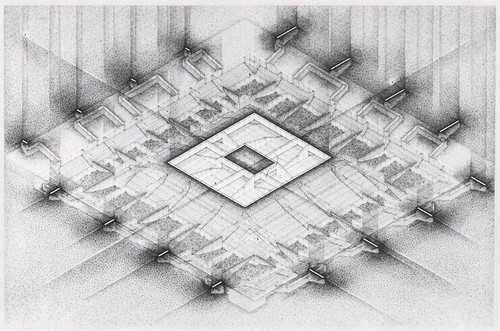 [Image: ONECITY by Will Insley; image via The Nonist].
[Image: ONECITY by Will Insley; image via The Nonist].
The New York Times described it at the time as depicting an "imaginary labyrinth 650 miles square." It is "'situated' between the Mississippi and the Rockies and consists of many 2 1/2-mile-square structures, each divided into an 'Over-building' and an 'Under-building' and each containing nine arenas."
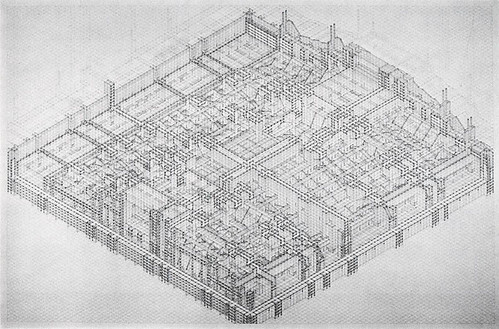
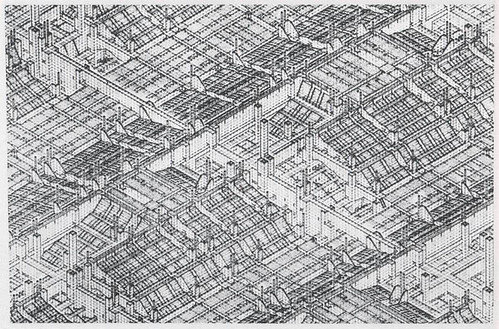 [Images: ONECITY by Will Insley, via The Nonist].
[Images: ONECITY by Will Insley, via The Nonist].
The artist described his own interests as having "very little to do with advanced planning theories of the present" and no relation really at all to the ''utopias of the future, but rather with the dark cities of mythology, which exist outside of normal times in some strange location of extremity.''
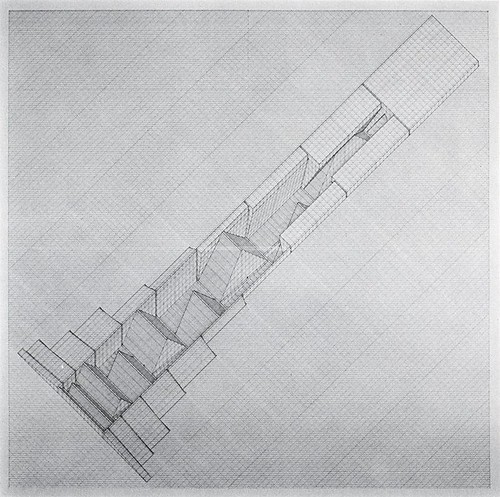
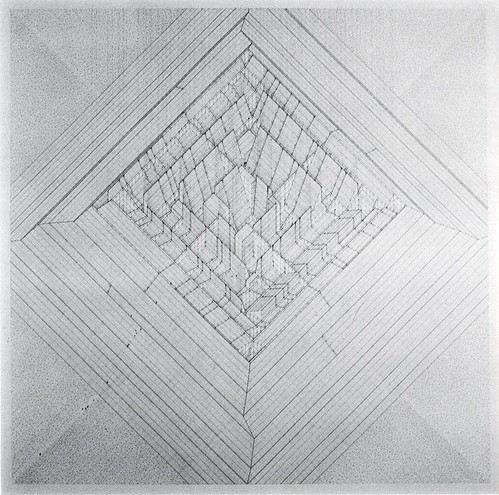 [Images: ONECITY by Will Insley].
[Images: ONECITY by Will Insley].
Courtesy of a comment left a while back on the sorely-missed site The Nonist, we learn that Insley once quipped: "what was absent from the ruin is often less marvelous than we imagine it to have been. The abstract power of suggestion (the fragment) is greater than the literal power of the initial fact. Myth elevates.’" These mythic fragments of a city that never was thus take their artistic power more from suggestion—of possible archaeologies and future extensions, impossible events this civilization of the plains might yet undergo—rather than any sense of intended realizability.
 [Images: ONECITY by Will Insley].
[Images: ONECITY by Will Insley].
Continuing from the New York Times, meanwhile:
In any case, you can see a few more images of Insley's Michael Heizer-like creation of excavations and voids over at The Nonist.
 [Image: ONECITY by Will Insley; image via The Nonist].
[Image: ONECITY by Will Insley; image via The Nonist].The New York Times described it at the time as depicting an "imaginary labyrinth 650 miles square." It is "'situated' between the Mississippi and the Rockies and consists of many 2 1/2-mile-square structures, each divided into an 'Over-building' and an 'Under-building' and each containing nine arenas."

 [Images: ONECITY by Will Insley, via The Nonist].
[Images: ONECITY by Will Insley, via The Nonist].The artist described his own interests as having "very little to do with advanced planning theories of the present" and no relation really at all to the ''utopias of the future, but rather with the dark cities of mythology, which exist outside of normal times in some strange location of extremity.''

 [Images: ONECITY by Will Insley].
[Images: ONECITY by Will Insley].Courtesy of a comment left a while back on the sorely-missed site The Nonist, we learn that Insley once quipped: "what was absent from the ruin is often less marvelous than we imagine it to have been. The abstract power of suggestion (the fragment) is greater than the literal power of the initial fact. Myth elevates.’" These mythic fragments of a city that never was thus take their artistic power more from suggestion—of possible archaeologies and future extensions, impossible events this civilization of the plains might yet undergo—rather than any sense of intended realizability.
 [Images: ONECITY by Will Insley].
[Images: ONECITY by Will Insley].Continuing from the New York Times, meanwhile:
- It's clear, however, that the city's inhabitants are segregated into day people, wholesome types who study at home with their children by means of electronic devices, and night people. "Tattered ghosts in phosphorescent clothing," the night people sound a lot like the more Felliniesque denizens of the Lower East Side, being given to masks and elaborate makeup; they "mutter a lot" and "often carry around personal abstract structures" that they exchange "according to mysterious rituals." And while they have homes in the Over-building, they frequently sleep in the cubby holes of the Under-building, ignored by day people going about their business.
In any case, you can see a few more images of Insley's Michael Heizer-like creation of excavations and voids over at The Nonist.





Comments are moderated.
If it's not spam, it will appear here shortly!
has me thinking of Asimov's caves of stell.
An article on Insley's exhibition made Yuri I. Manin, a famous russian mathematician and intellectual, write up some of his ideas on cities and their myths, e.g. here "Empty City".
The first image looks remarkably like a computer chip. I wonder what parallels exist.
Thanks, T! I'd forgotten that that's actually where I first read about this project. Thanks for the reminder.
It's House of Leaves (http://www.amazon.com/House-Leaves-Mark-Z-Danielewski/dp/0375703764) that immediately springs to my mind.
Very interesting post. Thanks
Have you read Stephen Milhauser's short story (via Harper's) "The Next Thing"? Bears a similar premise.
I just found this video of a SimCity 3000 mega-city, and thought it fit in best with this post.
Enjoy:
http://www.youtube.com/watch?v=9ezZgAl6aN8
Post a Comment